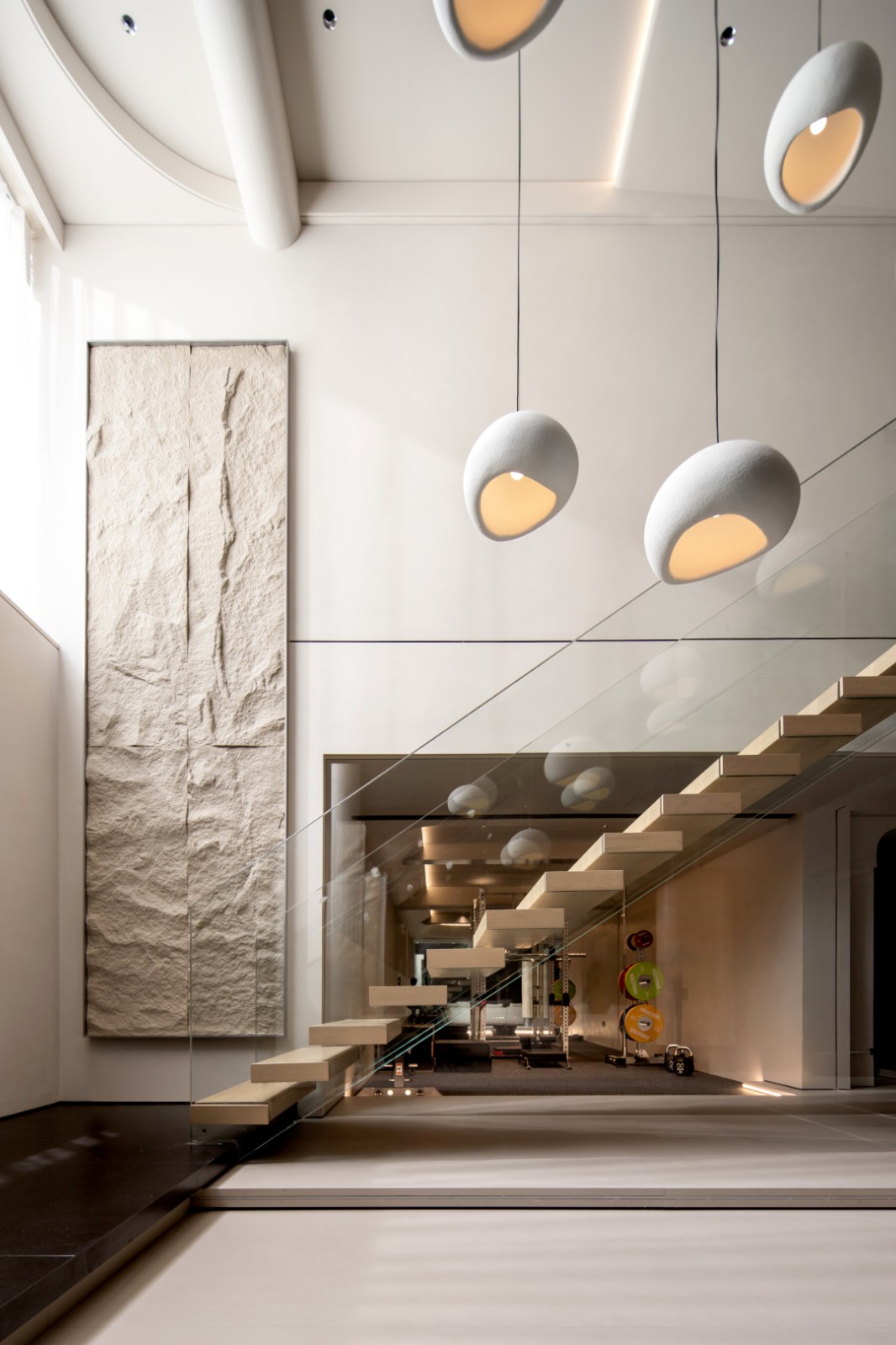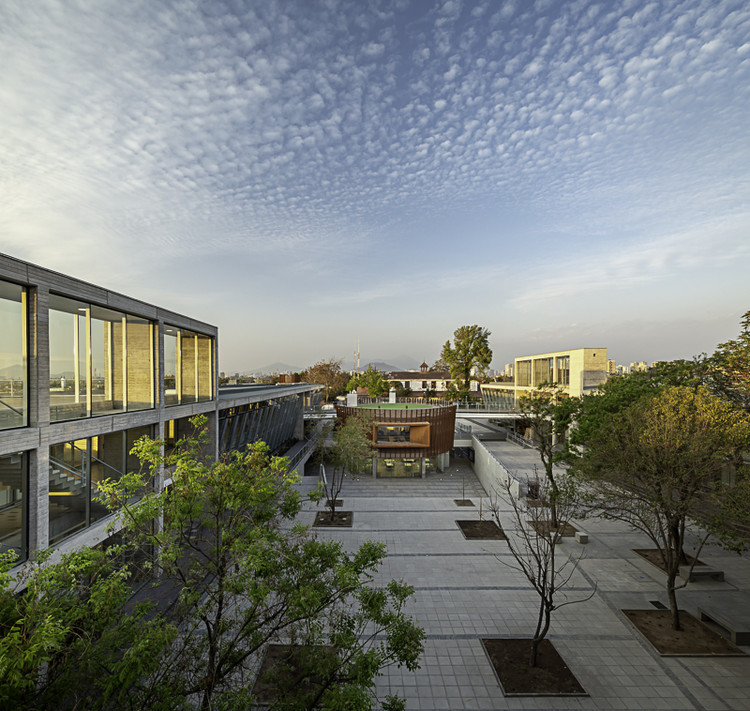Tempe Transportation Center Architekton
2011-08-30 01:00
© Bill Timmerman, A.F. Payne Photographic, Architekton, Otak, Skip Neeley
(B)Bill Timmerman,A.F.Payne照片,Architekton,Otak,Skip Neeley
Architekton的Tempe运输中心是一个为互动和社区而设计的地方。这种建筑形式反映了聚集空间与为城市居民和凤凰城地区服务的高效、合理的使用组织并置的特殊性质。坦佩交通中心(Tempe TransportCenter)是坦佩(Tempe)获奖交通项目的核心,旨在成为社会和交通枢纽。这一三角城市场地的复杂性包括繁忙的轻轨平台、海登·布特、ASU太阳魔鬼体育场和Tempe警察/法院/监狱建筑群。历史悠久的市中心和广阔的ASU校园(69,000名学生)由交通中心提供服务,交通中心是新的20英里地铁轻轨系统、地方和地区公共汽车、Zipcar和亚利桑那州第一个自行车站的战略枢纽。
Architekton's Tempe Transportation Center is a place designed for interaction and community. The architectural form reflects the special nature of gathering spaces juxtaposed against the efficient, rational organization of uses that serve city residents and the Phoenix metropolitan region. The Tempe Transportation Center is the centerpiece of Tempe’s award-winning transportation program, geared to becoming the social and transportation hub. The complexities of this triangular urban site include a busy light rail platform, Hayden Butte, ASU Sun Devil Stadium and the Tempe Police/Courts/Jail complex. The historic downtown and expansive ASU campus (69,000 students) are served by the amenities and transportation options of the Transportation Center, a strategic hub for the new 20-mile METRO light rail system, local and regional bus, Zipcar, and Arizona’s first bike station.
© Bill Timmerman, A.F. Payne Photographic, Architekton, Otak, Skip Neeley
(B)Bill Timmerman,A.F.Payne照片,Architekton,Otak,Skip Neeley
建筑物的放置被仔细考虑,以尊重,维护和框架海登布特的看法,一个神圣的文化遗址,为土著美国人。在人口稠密的市中心提供各种交通选择,提供食品、零售和服务设施,提高用户的舒适度、健康和安全,这一理念导致了一种与人造环境相结合的设施,同时包含了经济、社会和环境可持续性的目标。铺路材料反映了山区的颜色,适应了沙漠,本土植物调色板补充了现有景观。新设计的过境掩蔽所承认,需要垂直遮阳板在沙漠西南部。藤蔓的支持,以加强通风和冷却空气,而半透明的玻璃面板提供深阴影和转移雨水。宽阔的树冠树荫树在取水、调水、冷却铺路、减少城市热岛效应的同时,将逐渐成熟,以缓解阳光照射。
Building placement was carefully considered to respect, maintain and frame views of Hayden Butte, a sacred cultural site for Native Americans. The concept of providing a variety of transportation options in the dense downtown, with food, retail and service amenities enhancing user comfort, health and safety led to a facility that integrates with the man-made environment while encompassing goals of economic, social and environmental sustainability. Paving materials reflect the color of the mountain and the desert adapted and native plant palette complements the existing landscape. The new design of the transit shelters acknowledges the need for vertical shade panels in the desert Southwest. Vines are supported to enhance ventilation and cool the air, while translucent glass panels provide deep shade and divert rain. Broad canopy shade trees will mature to provide relief from the sun while collecting and redirecting water, cooling the paving and reducing the urban heat island effect.
© Bill Timmerman, A.F. Payne Photographic, Architekton, Otak, Skip Neeley
(B)Bill Timmerman,A.F.Payne照片,Architekton,Otak,Skip Neeley
这座40,300 sf三层楼的大楼内有该市的交通办公室、交通管理中心、社区室、过境商店和亚利桑那州的第一个自行车站。底层零售和餐饮服务为公共汽车和铁路乘客、ASU学生和游客提供便利。自行车赛勒提供自行车架和四个更衣室,有淋浴和储物柜,提供自行车销售,租赁,修理和配件。这一成功的设计可以复制在未来的多式联运网站,以减少碳和支持社区健康。
The 40,300 sf, three-story building houses the city’s Transportation Offices, Traffic Management Center, Community Room, Transit Store, and Arizona’s first bike station. Ground floor retail and food service provide amenities for bus and rail patrons, ASU students and visitors. The Bicycle Cellar provides bike racks and four changing rooms with showers and lockers, offering bike sales, rentals, repairs and accessories. This successful design can be replicated at future multi-modal sites to reduce carbon and support community health.
Building Performance Diagram
开发了高性能建筑围护结构和集成系统,并对其进行了计算机建模测试,使能耗降低了52%。这在一定程度上是通过太阳面纱来实现的,它可以保护东方的钢铁和从黎明到中午的玻璃,以防止早晨的热量增加。松散的织物屏幕被部署在黎明和收回中午,可以手动调整从内部通过遥控。遮阳在强风中自动收缩,响应安装在屋顶上的传感器。太阳能电池板为建筑物提供热水,并为今后在屋顶上安装光伏电池板提供了管道。
The high-performance building envelope and integrated systems were developed and tested with computer modeling, resulting in a 52% reduction of energy use. This is accomplished in part with a solar veil that protects the east facing steel and glazing from dawn to noon to prevent morning heat gain. The loose weave fabric screens are deployed at daybreak and retracted at noon and can be manually adjusted from the interior by remote control. The shades automatically retract during high winds, responding to roof mounted sensors. Solar panels provide hot water to the building, and conduit is in place for future installation of photovoltaic panels on the roof.
© Bill Timmerman, A.F. Payne Photographic, Architekton, Otak, Skip Neeley
(B)Bill Timmerman,A.F.Payne照片,Architekton,Otak,Skip Neeley
采用优质材料开发了一座使用寿命80~100年的建筑.平面图的位置支持用途(出口楼梯,机械,复制和存储室,午餐室)沿西墙,保护日常占用的办公区域,并创造一个灵活的空间,可以随着时间的推移。凸起楼面的2‘x2’混凝土面板可拆除和重新布置,以适应办公布局的变化,并可拆除、储存和重新配置DIRTT内部玻璃和钢办公室墙系统,以改变功能,消除拆迁浪费,减少施工时间。
Quality materials were used to develop a building with a useful life of 80-100 years. The floor plans place support uses (exit stairs, mechanical, copy and storage rooms, lunch room) along the west wall, protecting the daily-occupied office area and creating a flexible space that can change over time. The 2’x2’ concrete panels in the raised floor can be removed and rearranged to accommodate changes in office layouts and the DIRTT interior glass and steel office wall system can be removed, stored and reconfigured as functions change, eliminating demolition waste and reducing time of construction.
© Bill Timmerman, A.F. Payne Photographic, Architekton, Otak, Skip Neeley
(B)Bill Timmerman,A.F.Payne照片,Architekton,Otak,Skip Neeley
这座建筑包括了一些创新,包括城市办公/商业大楼的第一个沙漠绿色屋顶。屋顶是山和广场的视觉延伸,从海登·布特(HaydenButte)和附近的城市建筑可以看到。12“土工配合物和低维护设施在严寒的夏季高温下稳定结构温度,缓冲空中交通噪声,保护屋顶膜,过滤雨水。
The building includes a number of innovations, including the first desert green roof on an urban office/commercial building. The roof is a visual extension of the mountain and the plaza, visible from Hayden Butte and nearby urban buildings. The 12” soil mix and low maintenance plants stabilize the temperature of the structure in the severe summer heat, buffer noise from overhead air traffic, preserve the roof membrane and filter rain water.
© Bill Timmerman, A.F. Payne Photographic, Architekton, Otak, Skip Neeley
(B)Bill Timmerman,A.F.Payne照片,Architekton,Otak,Skip Neeley
一个15,000加仑的雨水回收系统从屋顶、邻近的警察局sallyport收集水,并从公共汽车车道和公共广场的常规动力清洗中收集水。再生水是用于滴灌低水沙漠植物和树木的现场.无水小便池和低流量装置是标准的和双冲马桶,充满来自淋浴和水槽的灰色水。水调节系统最大限度地利用了冷水机组中的水。
A 15,000-gallon stormwater recovery system collects water from the roof, the adjacent Police sallyport, and from routine power washing of the bus lane and the public plaza. Recycled water is used for drip irrigation to low-water desert plants and trees on site. Waterless urinals and low flow fixtures are standard and dual flush toilets fill with graywater from showers and sinks. A water conditioning system maximizes reuse of water in the chiller.
© Bill Timmerman, A.F. Payne Photographic, Architekton, Otak, Skip Neeley
(B)Bill Timmerman,A.F.Payne照片,Architekton,Otak,Skip Neeley
可操作的窗户和大的滑动门提供了替代的冷却机会和与自然环境的连接。北面和南面的社区客房开放,创建了一个高架集合空间,回忆起历史上常见的“亚利桑那房间”前使用空调。日光取代了整个建筑物的架空电气装置。每个工作站和办公室都安装了任务照明和LED灯。
Operable windows and large sliding doors provide alternative cooling opportunities and a connection with the natural environment. The north and south elevations of the Community Room open to create an elevated gathering space recalling the historic “Arizona room” common before the use of air conditioning. Daylight takes the place of overhead electric fixtures throughout most of the building. Task lighting and an LED lamp are installed at each workstation and office.
© Bill Timmerman, A.F. Payne Photographic, Architekton, Otak, Skip Neeley
(B)Bill Timmerman,A.F.Payne照片,Architekton,Otak,Skip Neeley
这一三角形城市场地的复杂性构成了一个设计挑战,迫使研究多个规划互动。导致重建的警察港口(进入低级监狱)的安全标准,限制西面砖墙的窗户,影响外部照明水平,并修改建筑物的通道。该物业复杂的自然坡度需要敏感的执行,以管理公共汽车转弯运动、排水和用户可达性。在人口稠密的市中心提供各种交通选择,提供食品、零售和服务设施,提高用户的舒适度、健康和安全,这一概念导致了一种与人造环境相结合的设施,同时包含了经济、社会和环境可持续性的目标。运营和维护大楼需要教育,并促使个人质疑阻碍环境保护的程序和政策。
The complexities of this triangular urban site make for a design challenge that forces the study of multiple programed interactions. Leading to a security criteria for the reconstructed Police sallyport (accessing the below-grade jail), restricting windows in the west-facing masonry wall, impacting exterior lighting levels, and modified building access. The complex natural slope of the property required sensitive execution to manage bus turning movements, drainage and user accessibility. The concept of providing a variety of transportation options in the dense downtown, with food, retail and service amenities enhancing user comfort, health and safety led to a facility that integrates with the man-made environment while encompassing goals of economic, social and environmental sustainability. Operating and maintaining the building requires education and prompts individuals to question procedures and policies that impede environmental preservation.
© Bill Timmerman, A.F. Payne Photographic, Architekton, Otak, Skip Neeley
(B)Bill Timmerman,A.F.Payne照片,Architekton,Otak,Skip Neeley
通过公共广场上的教育互动绿色触摸屏,展示对气候敏感的设计和回收的内容材料,展示设计过程、施工方法、LEED策略和建筑系统。该项目过程的一部记录片包括考古发现的具有历史意义的Hohokam建筑和文物(公元600年至公元1450年),这些发现为当前有关沙漠粮食生产和水资源保护的讨论提供了信息。
The climate responsive design and recycled content materials are unveiled to visitors through an educational interactive Green Touchscreen on the public plaza, displaying the design process, construction methods, LEED strategies, and building systems. A documentary film of the project process includes archeological discoveries of historic Hohokam structures and artifacts (600 AD to 1450 AD) from the site that inform current conversations of food production and water conservation in the desert.
© Bill Timmerman, A.F. Payne Photographic, Architekton, Otak, Skip Neeley
(B)Bill Timmerman,A.F.Payne照片,Architekton,Otak,Skip Neeley
增加植被屋顶支持本地鸟类,蜜蜂和蝴蝶。建筑废物减少94%,利用当地、快速可再生、可再生和可循环利用的材料含量保存自然资源。地毯和家具是GREENGUARD认证。第一个双室垃圾贮器被安装,压缩回收物在一边,垃圾在另一边,以减少多次皮卡,燃料消耗和工时。低或无VOC油漆和无毒的胶水和产品,地板下的空气分配,自然光和视图提高了员工的健康和生产力。安装节能水泵、马达、空气交换器、板框换热器、传感器、灯和LED出口标志,除每年节省能源外,还提供了超过1.9万美元的APS回扣。该项目正在寻求LEED白金认证。
The addition of the vegetated roof supports native birds, bees and butterflies. Construction waste was reduced by 94%, and natural resources were preserved by use of local, rapidly renewable, recycled and recyclable material content. Carpeting and furnishings are GreenGuard certified. The first double-chambered garbage receptacle was installed, compacting recyclables on one side and trash on the other to reduce multiple pickups, fuel consumption and man-hours. Low or no VOC paints and non-toxic glues and products, under floor air distribution, natural light and views enhance employee health and productivity. Installation of energy efficient water pumps, motors, air exchanger, plate-frame heat exchanger, sensors, lights and LED exit signs yielded an APS rebate of over $19,000, in addition to the annual operational energy savings. The project is seeking LEED Platinum certification.
© Bill Timmerman, A.F. Payne Photographic, Architekton, Otak, Skip Neeley
(B)Bill Timmerman,A.F.Payne照片,Architekton,Otak,Skip Neeley
向社区宣传可持续性的愿望导致了全国第一个“再利用/回收”标志项目,利用剩余的完成材料、建筑废料、旧公共汽车轮胎和废弃自行车。解释性标志和教育墙展示,扩大学习绿色建筑和产品的机会。公共艺术被整合在建筑设计中,将回收的玻璃渣融入院子的墙壁中,由彩色的LED灯光显示器点亮,随着时间的推移而改变。广场上蚀刻的花岗岩桥面是艺术家对该遗址在其历史上的使用方式的诠释。
The desire to inform the community about sustainability led to the first “Reuse/Recycle” signage program in the nation, utilizing left over finish materials, construction scrap, old bus tires and abandoned bicycles. Interpretive signage and educational wall displays expand opportunities to learn about green building and products. Public art is integrated in the building design, incorporating recycled glass slag in courtyard walls lit from within by colorful LED light displays that change over time. Etched granite pavers in the plaza are an artist’s interpretation of how the site was used throughout its history.
© Bill Timmerman, A.F. Payne Photographic, Architekton, Otak, Skip Neeley
(B)Bill Timmerman,A.F.Payne照片,Architekton,Otak,Skip Neeley
2008年12月,坦佩交通中心隆重开幕,与此同时,新的20英里长的地铁轻轨系统也开通了,吸引了来自全国各地的游客。当地社区一直急于了解建筑物和可持续的战略所使用的设计,采购,建筑,运营和维修。在建筑期间和入伙后的头六个月里,超过1200人参观了这座建筑。目前的教育机会将来自于测试、监测和完善运作系统和战略。将收集建筑数据,以跟踪饮用水使用量、再生雨水和灰水的使用量以及能源系统的性能。每年提高效率和降低业务费用的挑战将为世界各地干旱气候下的未来项目制定新的基准。
The grand opening of the Tempe Transportation Center in December 2008 coincided with the opening of the new 20-mile METRO light rail system, attracting visitors from across the country. The local community has been anxious to learn about the building and the sustainable strategies utilized for design, procurement, construction, operations, and maintenance. Over 1,200 people have toured the building during construction and through the first six months post-occupancy. The ongoing educational opportunity will result from testing, monitoring and refining the systems and strategies of operation. Building data will be collected to track reduction in potable water use, amount of recycled stormwater and graywater used, and the performance of energy systems. A challenge to improve efficiency and reduce operational costs annually will establish new benchmarks for future projects in arid climates around the world.
 举报
举报
别默默的看了,快登录帮我评论一下吧!:)
注册
登录
更多评论
相关文章
-

描边风设计中,最容易犯的8种问题分析
2018年走过了四分之一,LOGO设计趋势也清晰了LOGO设计
-

描边风设计中,最容易犯的8种问题分析
2018年走过了四分之一,LOGO设计趋势也清晰了LOGO设计
-

描边风设计中,最容易犯的8种问题分析
2018年走过了四分之一,LOGO设计趋势也清晰了LOGO设计

































































































